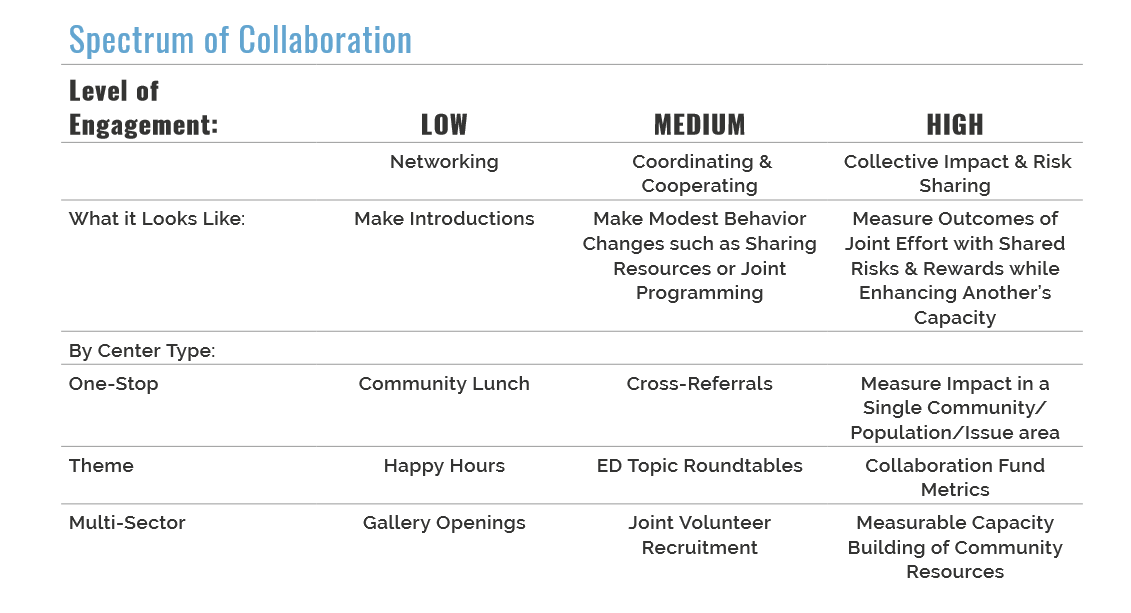The Nonprofit Centers Network recently conducted The Collaboration Project, a study that seeked to find the truth behind how much collaboration actually takes place in shared workspaces and why in some cases, the percentage found is significantly low.
What Is Collaboration?
The Nonprofit Centers Network (NCN) defines collaboration as “two or more tenants that work together, informally or formally, towards a common, mutually beneficial goal.”
However, during The Collaboration Project, participants found that this definition didn’t fully encompass all that collaboration can mean and all the different ways in which collaboration can happen.
“Cohort members recognized that the definition did not reflect the full range of ways collaboration is exhibited in shared space. The group devised a scale for different levels of engagement, each of which could be called collaboration. It was important to delineate the various levels of collaboration to assist practitioners in understanding and better communicating their expectations around collaboration.”
Low vs Medium vs High Level Collaboration
Lara Jakubowsky, Executive Director of NCN, tells us that one of the reasons The Collaboration Project took shape was because because various members and workspace centers were frustrated about the low levels of collaboration between tenants.
“Everyone was just doing their own thing, the same people were showing up to happy hours and potlucks.”Lara Jakubowsky, Executive Director of NCN, tells us that one of the reasons The Collaboration Project took shape was because because various members and workspace centers were frustrated about the low levels of collaboration between tenants.
Is this really a bad thing though?
Not necessarily. However, these are supposed to be opportunities to network, and once the same people start showing up everywhere, the chances of expanding your network decrease.
In the spectrum of collaboration defined during the project, happy hours and potlucks fall under the low category.

One of the most important findings of the project was the gap between what members expected, what workspace operators and managers expected, and what was actually happening in instances of collaboration.
Here’s what NCN found out.
What Workspace Operators Say
Lack of engagement; apathy among tenants around collaboration.
Tenants like the idea of collaboration but don’t make unilateral efforts to engage with others.
Want collaboration to be “organic” rather than imposed by operator.
Want to see large-scale program collaboration (joining forces on a campaign that encompasses both of their missions).
Want to be able to track collaborations, collect data, and demonstrate impact.
Difficult to balance the needs and expectations of small vs large tenants around collaboration.
Difficult to be “landlord – rule enforcer” and be seen as a neutral facilitator of collaboration.
Original agreements around collaboration may have been formalized, but over time proved unrealistic or were never implemented.
What Unengaged Members Said
We are too busy to collaborate.
Our goals are to reduce costs, not collaborate.
We are collaborating – we just had coffee with another tenant.
You communicate via email but we don’t want all of our employees to get bogged down in email from the Center so they aren’t on the list.
Haven’t taken the time to consider other organizations, because it requires more time and effort to think outside the box.
We are here part-time and not always on the days identified for an activity.
We have been waiting for opportunities to collaborate. It is why we joined the Center.
Turns out that “some centers and tenants are holding collaboration too tightly, and others are holding it too loosely” says Jakubosky. This leads to a significant amount of low engagement collaboration efforts, but not enough medium or high-impact ones.
This is what flexible workspace managers need to work on. Shared workspaces are laboratories for collaboration, and though at first it might be hard to get the wheels rolling, center managers do need to find the right tools and ways to encourage workspace members to collaborate with one another.
Though this might not seem organic at first, it will eventually lead to stronger and deeper connections that will motivate members to collaborate on their own, without much involvement from the workspace staff.
Go back in time, review your year, what do your collaboration campaigns look like? Do you have any? Which were the most successful?
If you think you have room to improve, stay tuned for Collaboration Best Practices, coming up next week here. In the meantime, here’s a word of advice from Jakubowsky: “have a collaboration plan; get your workspace members together, interview them, find out what they need or what they’d like to do. Then play matchmaker with them if you must.”


 Dr. Gleb Tsipursky – The Office Whisperer
Dr. Gleb Tsipursky – The Office Whisperer Nirit Cohen – WorkFutures
Nirit Cohen – WorkFutures Angela Howard – Culture Expert
Angela Howard – Culture Expert Drew Jones – Design & Innovation
Drew Jones – Design & Innovation Jonathan Price – CRE & Flex Expert
Jonathan Price – CRE & Flex Expert












